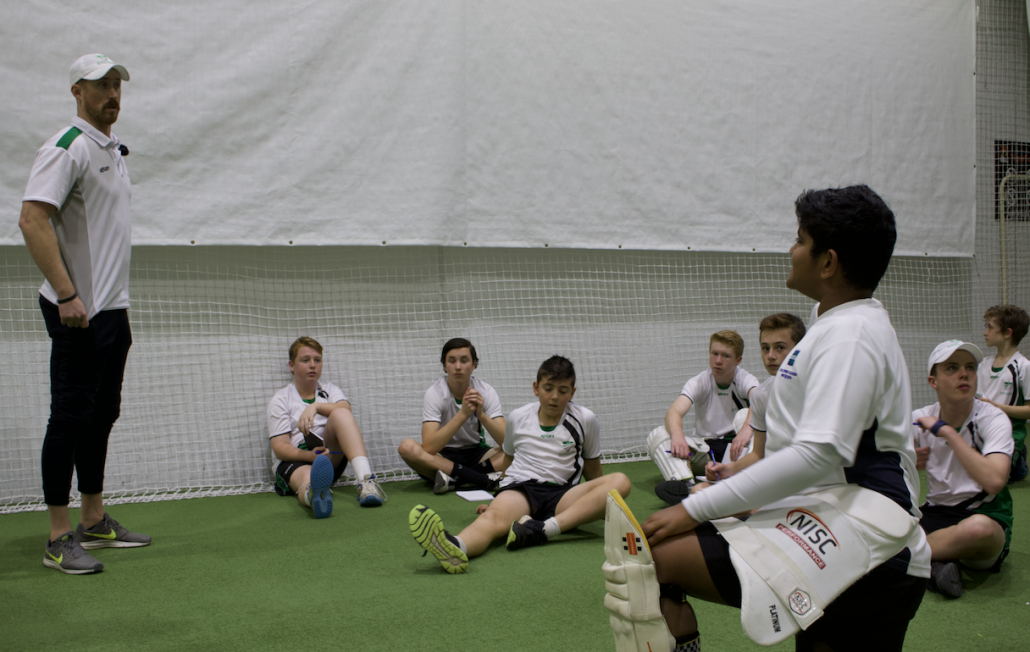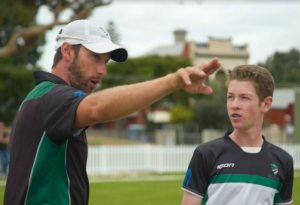In 2018 we were lucky enough to have young Queensland batsmen Sam Heazlett join us in one of our live online training sessions with our academy members, here's a little bit of what we spoke about with Sam.

Q: Tell us about your journey so far, as a junior and then where you’ve gotten to today.
My cricketing career started at Alex Hills Junior Cricket Club, just down the road from where I live and played bit of Milo Cricket down there and loved it. Then started playing in the u10’s and worked my way up through there.
Played club cricket all the way through, my school didn’t play cricket so was just club for me. Played a lot of other sports growing up, I loved just competing in anything really and got to an age (14 or 15) and really though I should probably choose what sport I should focus on, I played a lot of Rugby League as well and they sort of overlapped a bit there in the winter and summer.
I then continued on to play senior cricket for the Redlands Tigers where I still play today and made my way through there and was lucky enough to get picked in some rep sides like the Met East and other rep teams in the area’s. Loved that, had a great time with my mates. I had seasons where I didn’t score many runs, and then season’s when I did, that’s cricket and I guess the last few years had gone very fast. I got selected in the Australian under 19’s team after my Queensland U19 carnival and I guess it all ready started from there.
After having a good series against England U19’s I was awarded a Rookie contract with the Queensland Bulls. That was great that I was going to be able to train and play cricket full time, not really expecting to play many games, but would be great if I did and that was in 2017 where I was selected in the second shield game of the season and was lucky enough to take the opportunity and perform well which cemented my spot in the team for a little bit longer.
I then played a bit of big bash cricket that year as well which was awesome to play a few games in. This is my second year of shield cricket (2018) and also with the Heat in the Big Bash and yea like you mentioned to be selected in that Australian Squad and be in that group with the different coaching staff they have there it was a great experience. It is a similar set up to what the state systems have, but just a different bunch of people to learn off was really good.
Q:You’ve certainly had a massive couple of years, and you certainly had taken the Shield and Big Bash competitions by storm, did you think you were a sniff for getting picked for Australia?
I wasn’t expecting it at all, not really. I Guess the fact that the Indian tour was on soon and a couple of players had gone to Dubai to prepare for that and Steve Smith had got injured in the Pakistan One Day Series.I was just down at my local cricket club doing some cricket coaching and got a call from the National selector saying I was going to New Zealand the next day!
That was a surprise but I was definitely stoked to hear it. Obviously back in state cricket now and just looking to score as many runs as I can and see what happens from there.
Q:Yea nice, now in terms of when you were growing up, one of our philosophies here is to sort of follow in the right footsteps, so find mentors or coaches I guess that have achieved what you want to achieve and learn from them. Who were some of the mentors that have played a role in your cricket growing up?
Yea well I guess I’ve had a lot of mentors.It’s going to be hard to mention all of them but when I started under 10’s cricket I was coached by a bloke called Bryan Briggs who was a grade cricketer himself and I was playing with his son Grant at the time so I was lucky that things fell into line and I had a good coach in Brian at a young age.
Over the years I’ve had a lot of good coaches. Blair Copeland who is the Head Of Cricket at Gregory Terrace in Brisbane has done a lot of work with me recently and all the other coaches at Queensland Cricket, obviously a lot of high level coaches there. Other coaches at Cricket Australia and the National Performance Squad who have really changed my game for the better.
You hear a lot of things from coaches and you need to try it all but individually you have to find what works and what doesn’t.
Q:Growing up as a Youngster what were your training habits? And how have they evolved and increased to where they are now?
Yea I guess as a younger player it was just about having fun and just going to the nets and hitting and bowling a cricket ball, having a love of the game. I still do that now and do love it, but I guess I have a bit more of a focus.
It’s really important to go into a session with a focus, something technical that I might be working on, or mentally how to approach the session or trying different tactics against different bowlers. If I’m coming up against an off spinner next match I’ll try and face as much off spin as I can rather than leg spin to prepare for that match.
Obviously I train a lot more now which includes gym and running and spreads into other disciplines like that.
Q:Like you’ve said earlier it’s happened pretty quickly for you, you’ve gone up and played different levels fairly quickly. Say from junior cricket to senior cricket and from your rep junior stuff right through to state and international cricket, what’s the step up been like and what are things you’ve noticed stepping up the next level?
Yea I guess it is fairly gradual at each step of the way. Each step I’ve sought of thought to myself “alright, when am I going to get to the next level ?” and I really wanted to get to the next level, but I kept thinking to myself “ there’s so many people ahead of me in the pecking order. There’s this person, and this person etc. they are going to get selected before me, they are more experienced than me and will get selected next” I guess my advice is it’s not as far away as you think if you just enjoy it and do your best. Don’t worry about selection too much, worry about what you can control then things will happen and you’ll get the opportunity.
I guess the biggest jump is going from junior cricket to senior grade cricket, where you are playing against people your own age compared to playing against older men who are experience and have that strength who may be able to bowl a little faster or get more bounce or hit the ball harder without the same technique that I may have played against in junior cricket. Yea that was probably the biggest step up.
Q:What about mentally, are they a little more aggressive on the field as well?
Yea I guess you experience different challenges on the field with that extra pressure of getting into your head. I think when you get up the next level you want to prove yourself again. There are a few guys I’ve not seen and others that haven’t seen me play so I had to sort of prove that I can perform well and have to show them how good I am. That can be that extra pressure as well, especially if you don’t believe that you should be there, it’s a big confidence thing cricket, and if you get there and think maybe I’m not good enough or maybe I’m a bit underdone and that’s going to negatively affect your performance. Have that confidence and I think that I’ve learnt that every step of the way you’ve just got tell yourself that you are good and you are going to succeed and perform well.
Q:Having a look at the mental side of the game, how much of a part do you think that plays on a players success? Being strong mentally?
Yea massive!
Yea the mental side of things, depends on weather you are talking the confidence side of things or your plan going out to play or approach, but it’s going to affect it a-lot.
I think you’ve got to be well planned…
You need to figure out what works best for you. As a batter or bowler your always going to be finding out what works best throughout your whole career, I don’t think any player gets to a point and says “alright this is what works every time” and not change. Especially when conditions change and you are facing different types of bowlers your not used to. Being able to have a plan but also adapt and find new ways to succeed in new challenges and that’s important as well.
Q:What about nerves, do you experience nerves and if so, to what extent and how do you deal with it?
Yea look I’m nervous every time I go out to play, no matter what level it is. I always want to succeed and do well, I don’t like loosing and getting out.
I want to be out in the middle cause that’s where I have the most fun, contributing to a win for the team. I guess you’ve just got to use that nervous energy as best as you can, it’s not a bad thing that you’re nervous, it means you care you want to do your best which is a good thing.
If you trust in your practice and training and trust that you’ve done the work and it’s going to work, that’s all that you can do. As a batsman you might get a good ball first ball, jags away and catches the outside of the edge and you are off, but that’s the way cricket is and you’ve just go to have the approach that you can just take each ball as it comes and do your best.
Q:What’s been your biggest set back so far since you started playing cricket and how did you deal with that?
There’s different ones and different types of setbacks. Not getting selected in teams as a younger player isn’t ideal growing up you might get disappointed about that but you can’t let it affect you too much.
For me it’s injuries that frustrate me the most, I’ve been lucky that I haven’t had many bad injuries. This year I injured myself in the NPS 4 way series against India A, South Africa A and Australia A and the last game I tore my quad, I had a really good carnival up there and was looking good and looking forward to playing the Matador Cup for QLD.
I just had a good white ball series and was confident in what I could do and to injure myself in that last game meant I missed about 9 or 10 weeks and missed the Matador Cup which was disappointing but I guess in the future now, I’ve started playing shield cricket again and I also got a chance to represent Australia so I guess in the short term when you have that set back it’s going to have a massive negative affect in every way but in the end if you have a positive attitude it will all work out well.
Q:The tactical side of the game. How did you go about improving your tactical side of the game and game awareness?
Yea I guess you’ve got to talk to the more experienced guys in your team, people who’ve been there before and have more experience in that part than you. Your coaches, you learn from your coaches in the team.
Talk cricket and think about different things. I think just discussing with different team mates, they have a different view on things and if you just speak with them as well.
Through junior cricket I was thrown in the deep end a little and made captain of many teams. Even if you are given the opportunity to be captain I guess it can be daunting as you are in control of the field settings and bowling changes and things like that which are going to have an impact on the result of the game. I think you learn pretty fast when you have to experience that. I think being thrown in the deep end like that and having a go is all you can do. Having a crack and having a reason behind your plan or behind what you are doing then that’s all you can do really.
Q:How much emphasis do you put on the physical aspect of the game? And did you place much emphasis on it growing up or has it just only really been like that since you’ve been a professional?
Yea, definitely I was always very active when I was younger and tried to eat well I thought that was just important for overall health, not just in sport, I just wanted to be healthy. I guess now I feel like it’s important because of injuries, you sit back now and think I just wish I was just that little bit stronger so that didn’t happen.
You think I’ve really gotta work hard in area’s that you think you may be deficient, but also to be the best player you can be. If you are that little bit quicker or bit faster you can run between the wickets faster and score more runs that way you can be a better fielder and teams definitely value good fielders.
Guys who can take catches and get run outs in the field, I guess if you are stronger you can hit the ball further without putting much effort in or be more controlled in the shots you are playing. As a bowler might be to bowl that little bit faster or bowl with more controlled and bowl more spells.
Q:Yea definitely, is there anything physically that you do religiously?
Ah, not too much I guess with being in the Qld set up and the Brisbane Heat, a lot of the running and strength sessions are planned out for us with the Sports Scientists and Strength & Conditioning Coaches. We are lucky we have that structure with people who know exactly what to do and how to structure it around games. Obviously you want to be as fresh and you can for the game, but knowing if you’ve got a few days off, a run or gym session is going to help.
You have to do things to relax and take your mind off it. I’m studying at Uni, that little bit of uni is a good way to spend my time and take my mind off cricket. I like to go surfing, for me it’s still activity and physical which helps me build up my strength and fitness as well.
Q:Is there anything that you change technically between all three formats?
Nothing technically in terms of batting stance etc. I change a bit between facing pace and spin, but between the three formats I stay fairly similar. Across the three stages I might change some small things like batting out of the crease or on leg stump. Depends on what the ball is doing, swinging or reverse swinging or spinning a different way. It’s more what’s happening in the game rather than a technical batting stance etc.
In terms of my mindset when it comes to the different formats, is slightly different. I have a bit more positive mindset in white ball, but I guess it’s more my plan. My plan to play certain shots, in 4 day cricket my plan is to play more limited shots as you’ve got more time and the red ball moves around more than a white ball will.
I still want to make sure I’ve got a positive mindset in the 4 day stuff. If I get a bad ball I’m going to want to put it away as I don’t want to miss out on the opportunity. I think it’s more the plan thinking about the stage of the game and in the nets knowing what the field would be and trying to play that way.
Q:What do you do to reflect on how you got out in the game and improve on so it doesn’t happen again and how do you move on?
I guess now days I’m lucky enough that I get to have vision that I can look back on after the game. I can go back and have a look at certain things such as my pre ball movement to see if I get that right or my balance and head which I can look at in the vision which is good.
When it wasn’t vision, I used to write down what I thought about my dismissal. I might have gone back over my innings and at the start i’d jot down this was my plan, this is what I was looking to do against these bowlers and this is how it worked out. Did it work? Did it not? And also how the innings progressed and all the details of the different bowlers and how I faced them/what was my plan/ how I got out, would this be different the next time and how could I improve etc.
Journalling on those innings really helps as you can look back in your season and collate on what did and didn’t work.
In terms of moving on, like I said earlier you want to score a hundred every time but it doesn’t usually happen. Often and that’s what makes it so exciting when you do succeed. As a junior when I didn’t perform well I did get down and upset but I guess it’s just about having a positive attitude and thinking that it is going to work next time. Have confidence that what you’ve done at training is going to work. If you do have a bad innings go alright, I’m going to go and train hard this week and enjoy it.










